Photoelectric proximity sensors from various product families, fiber-optic sensors, inductive proximity sensors, laser sensors, and safety locking devices - SICK sensor technology plays a crucial role in Flowtos tissue machines from Winkler+Dünnebier. High detection quality, simple integration, incorporation of custom requirements, successful cooperation over many years, and close consultation with SICK right from the design phase were the main reasons why this engineering company opted to buy all the devices it needed from a single source.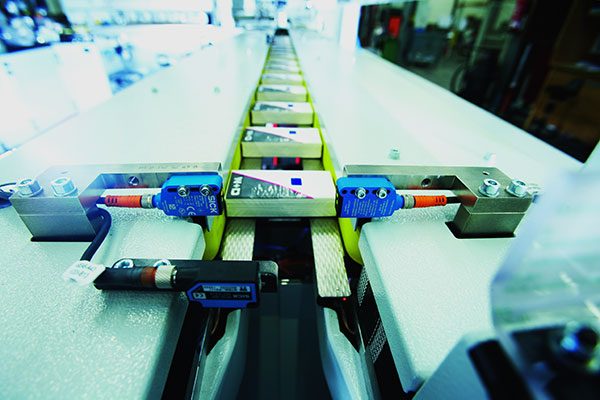 WL9G photoelectric sensors, which are specially designed to detect transparent objects and materials, check that the packet has been sealed correctly
WL9G photoelectric sensors, which are specially designed to detect transparent objects and materials, check that the packet has been sealed correctly
As a worldwide leading technology and system partner, Winkler+Dünnebier GmbH (W+D) offer a wide range of efficient, integrated complete solutions for the mail and postal industry as well as for the tissue and hygiene industry. With the innovative engineering concept of its Flowtos tissue machine, W+D provide a complete solution for producing tissues. The machine is fitted with servo technology and electronics throughout, making it extremely flexible. This makes it possible to produce a wide range of format and packet variations. Thanks to the complex functioning of the machine, folded and packaged tissues can be produced from 2-ply, 3-ply, or 4-ply tissue rolls within seconds, with up to 4,600 units completed in one minute. In order to ensure smooth performance, downtime must be avoided at all costs. This requires the use of a huge range of sensors which differ in their physical operating principles but function reliably in any case. W+D also needed to be able to buy all of its sensor technology from a single source, including detailed consultation regarding the optimal solution for each individual application.
Precise processes, step-by-step: unrolling, smoothing, and compressing
The Flowtos from W+D is a two-lane tissue machine with an integrated packaging and bundling system. And just as efficiently the machine itself works, so does the integrated sensor technology from SICK. It ensures precision and smooth transitions between the individual process steps and is made up of a sequence of modules such as an unrolling station, a smoothing and compressing station, a cutting, folding, and stacking unit, and an individual packaging system with an integrated turning and bundling station: In the unrolling station, tissue material is unraveled from a roll approximately two meters in diameter. The diameter of the roll, as it is being unrolled, is continuously monitored by a WT14-2 small photoelectric sensor. The sensor is mounted so that it can move to enable the different core diameters of the rolls to be taken into account and allowing it to reliably detect when the end of the roll has been reached. The precise background blanking function of the WT14-2 ensures reliable detection even in critical environmental conditions. In the unrolling station the diameter of the roll as it is being unrolled is continuously monitored by a WT14-2 small photoelectric sensor. An additional small photoelectric sensor in the unrolling station, a WT18-3, monitors the unrolling process, checking for any rips in the sheet. The sensor's high level of immunity to ambient light sources and HF lamps in the field guarantees reliable switching behavior.
In the unrolling station the diameter of the roll as it is being unrolled is continuously monitored by a WT14-2 small photoelectric sensor. An additional small photoelectric sensor in the unrolling station, a WT18-3, monitors the unrolling process, checking for any rips in the sheet. The sensor's high level of immunity to ambient light sources and HF lamps in the field guarantees reliable switching behavior. 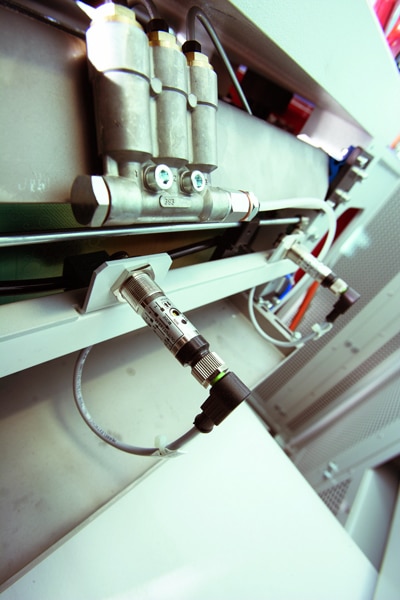 Cylindrical photoelectric sensors from the VT180-2 product family
Cylindrical photoelectric sensors from the VT180-2 product family
In the smoothing and compressing station, the tissue is smoothed and compressed in a calender to join the individual layers of tissue together at the edges. Thereby, the tension of the sheet is controlled electronically via the servo drives. To ensure that tissue does not become wound round the calender rollers unintentionally and to detect material residue in the compression area, W+D employ cylindrical photoelectric sensors from the VT180-2 product family. The cylindrical M18 design of the metal housing makes it easy to integrate into the system. The sensor can reliably differentiate between the shiny surfaces of the rollers and the moving sheet of tissue, despite them having similar remission properties. And, finally, the high switching frequency of 1,000 Hz ensures that the sensor responds quickly and with a minimum loss of material.
High process reliability during cutting, folding, and stacking processes
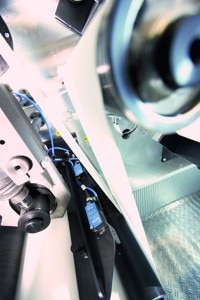 WT18-3 small photoelectric sensor scanning the sheet of tissue
WT18-3 small photoelectric sensor scanning the sheet of tissue
In the cutting, folding, and stacking module, the compressed sheet of tissue is slit, folded, and fed to a stacking magazine. A WT18-3 small photoelectric sensor is integrated in the slitter to scan the sheet of tissue. The sensors are directly connected to the motor controller, which significantly reduces the amount of cabling required in the machine, as well as minimizing the communication load of the automation system. A WTB8L miniature photoelectric sensor then detects the correct length of the cut tissue. W+D were convinced of the sensor's suitability thanks to its compact design and - due to the small light spot on the material - its highly precise and rapid switching behavior.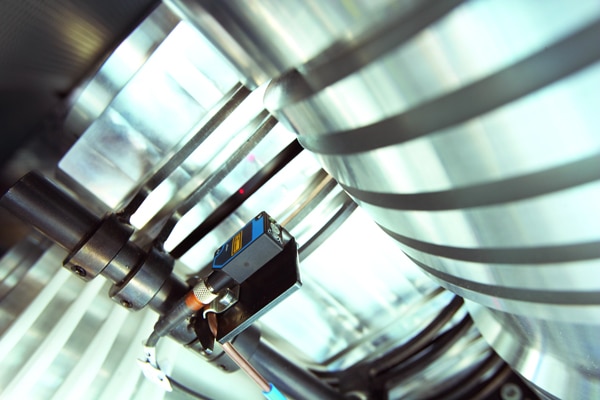 Miniature photoelectric sensors from the WTB8L product family monitor the height of the packets of tissues
Miniature photoelectric sensors from the WTB8L product family monitor the height of the packets of tissues
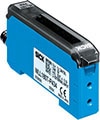 W+D have used WLL180T fiber-optic sensors to monitor the chutes and check for jams on the stacking unit. Further aspects in favor of these sensors include their compact size, fast response times of just 16 µs, and high light intensity and resolution, which ensures an additional operating reserve in this dusty operating environment.
W+D have used WLL180T fiber-optic sensors to monitor the chutes and check for jams on the stacking unit. Further aspects in favor of these sensors include their compact size, fast response times of just 16 µs, and high light intensity and resolution, which ensures an additional operating reserve in this dusty operating environment.  Once a stack of tissues has reached the specified size of ten tissues, for example, it is then transported to the individual packaging unit. Inductive proximity sensors from the IM12 product family have been installed in this section of the conveyor to scan for various positions and end positions. When it came to choosing a sensor, the IM12 stood out thanks to the compact M12 size of its metal housing with an IP67 enclosure rating, the option to install it flush in metal, and its high shock and vibration resistance.
Once a stack of tissues has reached the specified size of ten tissues, for example, it is then transported to the individual packaging unit. Inductive proximity sensors from the IM12 product family have been installed in this section of the conveyor to scan for various positions and end positions. When it came to choosing a sensor, the IM12 stood out thanks to the compact M12 size of its metal housing with an IP67 enclosure rating, the option to install it flush in metal, and its high shock and vibration resistance.
Reliable detection and monitoring during packaging
 In the individual packaging unit, where plastic film is conveyed to wrap the stack of tissues, an IMA18 inductive proximity sensor monitors the position of the dancer roll as the film is unrolled. The sensor has a triple operating distance, allowing it to offer a significantly larger detection range despite being the same size as standard sensors. Moreover, the IMA18 optionally provides an analog current or voltage signal, meaning that the dancer roll position can be continuously monitored within the detection field. The cutting of the film is triggered by a CS8 color sensor. Thanks to its three-color-LED technology, it is able to reliably detect the register marks that vary in terms of color and background in every situation. As soon as the tissues have been wrapped in film, the packet of tissues reaches the sealing station, where, first of all, the longitudinal seam on the packaging is sealed.
In the individual packaging unit, where plastic film is conveyed to wrap the stack of tissues, an IMA18 inductive proximity sensor monitors the position of the dancer roll as the film is unrolled. The sensor has a triple operating distance, allowing it to offer a significantly larger detection range despite being the same size as standard sensors. Moreover, the IMA18 optionally provides an analog current or voltage signal, meaning that the dancer roll position can be continuously monitored within the detection field. The cutting of the film is triggered by a CS8 color sensor. Thanks to its three-color-LED technology, it is able to reliably detect the register marks that vary in terms of color and background in every situation. As soon as the tissues have been wrapped in film, the packet of tissues reaches the sealing station, where, first of all, the longitudinal seam on the packaging is sealed.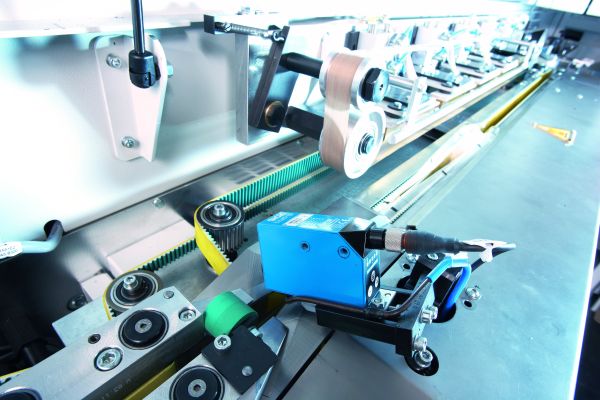 The cutting of the film in the individual packaging unit is triggered by a CS8 color sensor
The cutting of the film in the individual packaging unit is triggered by a CS8 color sensor
 Before the packet reaches the turning station, WTB8L miniature photoelectric sensors check that the longitudinal seam has been sealed correctly. The packet is then rotated and conveyed to the second sealing unit where the top and bottom of the packet are sealed. When the top is sealed, a sealing label is applied to the opening perforation on the packaging by a labeling machine - triggered by a WTB8 miniature photoelectric sensor with background blanking.
Before the packet reaches the turning station, WTB8L miniature photoelectric sensors check that the longitudinal seam has been sealed correctly. The packet is then rotated and conveyed to the second sealing unit where the top and bottom of the packet are sealed. When the top is sealed, a sealing label is applied to the opening perforation on the packaging by a labeling machine - triggered by a WTB8 miniature photoelectric sensor with background blanking. check that the packet has been sealed correctly. These sensors are specially designed to detect transparent objects and materials. They can reliably detect whether film is sticking up, which would indicate that the seal is not correct, as well as whether a sealing label is missing. If a faulty packet of tissues is detected, it is discharged before it reaches the bundling system. The automatic discharge unit is also controlled by a WTB8 miniature photoelectric sensor.
check that the packet has been sealed correctly. These sensors are specially designed to detect transparent objects and materials. They can reliably detect whether film is sticking up, which would indicate that the seal is not correct, as well as whether a sealing label is missing. If a faulty packet of tissues is detected, it is discharged before it reaches the bundling system. The automatic discharge unit is also controlled by a WTB8 miniature photoelectric sensor.
Safe monitoring of protective devices at hazardous points
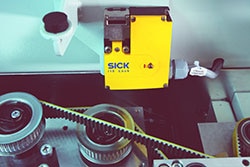 The unrolling station and the entire machine area between the stacking module and turning station prior to the second sealing station are fitted with a protective fence and/or protective covers for reasons relating to machine safety. The access door on the fence of the unrolling station and the mechanical covers in the central machine segment are monitored by safety locking devices from the i15 Lock product family. Owing to the fact that they are mechanical, spring and solenoid-locked safety switches with an IP67 enclosure rating and a rugged actuator head, they have also proven themselves to be reliable door monitoring devices even in the dusty operating environment of the Flowtos tissue machine. They ensure that it is only possible to replace the roll of paper or access the stacking unit, transport path, film unrolling station, and the sealing station when these modules are switched off. They also only allow the modules to be restarted when the mechanical protective devices are closed.
The unrolling station and the entire machine area between the stacking module and turning station prior to the second sealing station are fitted with a protective fence and/or protective covers for reasons relating to machine safety. The access door on the fence of the unrolling station and the mechanical covers in the central machine segment are monitored by safety locking devices from the i15 Lock product family. Owing to the fact that they are mechanical, spring and solenoid-locked safety switches with an IP67 enclosure rating and a rugged actuator head, they have also proven themselves to be reliable door monitoring devices even in the dusty operating environment of the Flowtos tissue machine. They ensure that it is only possible to replace the roll of paper or access the stacking unit, transport path, film unrolling station, and the sealing station when these modules are switched off. They also only allow the modules to be restarted when the mechanical protective devices are closed.
Successful consultation concept
The fact that the Flowtos machine is fitted almost entirely with sensors from SICK, and especially the fact that SICK experts provided a consultancy service from early on in the design phase of the machine demonstrate that SICK's consultation concept is a great success. We have received expert advice and service for what is now more than 25 years, confirms Frank Jungbluth, project manager for Flowtos electrical engineering at W+D in Neuwied. SICK employees provided support - sometimes even at weekends - and urgent verbal queries were always answered promptly and professionally. If then SICKs portfolio suits the needs of W+D, there will be no obstacles to a close cooperation even in the future.
- Product information: WT14-2 small photoelectric sensors, WT18-3 small photoelectric sensor, VT180-2 cylindrical photoelectrical sensor, WTB8L miniature photoelectric sensor, WTB8 miniature photoelectric sensor, WLL180T fiber-optic sensor, IM12 inductive proximity sensor, IMA18 inductive proximity sensor, CS8 color sensor, i15 Lock electro-mechanical safety switch
- Product portfolio: Photoelectric sensors, fiber-optic sensors and fibers, color sensors, inductive proximity sensors, electromechanical safety switches
- Customer information: Winkler+Dünnebier

